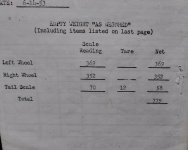bob turner
Registered User
Yes, but:
If it is a Cub, you really don't have to worry about unbalancing controls. What you are worrying about is losing 100 lbs of useful load. If that is ok, then by all means weigh it.
But then, I would think that, having done that, you would be reluctant to load above the legal max, for the same reason that drove you to weigh it. You want to be 100% legal.
If it is a Cub, you really don't have to worry about unbalancing controls. What you are worrying about is losing 100 lbs of useful load. If that is ok, then by all means weigh it.
But then, I would think that, having done that, you would be reluctant to load above the legal max, for the same reason that drove you to weigh it. You want to be 100% legal.





